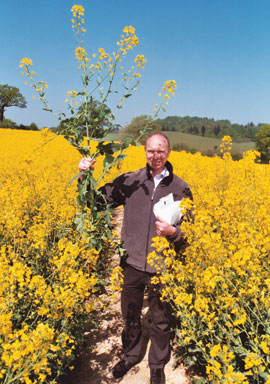Later metconazole applications can have yield benefits

Metconazole is known to reduce lodging after applications at stem extension, but later applications can also give yield benefit, research has shown.
Work carried out by ADAS, in conjunction with BASF, has shown a later metconazole application at early flowering gives a useful manipulation of the canopy.
“Oilseed rape has a large terminal raceme, and the later spray works by reducing the apical dominance so the plant compensates by producing a higher number of lower branches,” says Pete Berry of ADAS (pictured).
“The reduction in the size of terminal raceme subsequently reduces the flower layer, which results in less light being reflected at the top of the canopy. This allows more light through to the green area of the canopy for photosynthesis,” he says.
The better light penetration into the canopy results in lower pods producing more seeds a pod and increased seed yield overall. Pod development and ripening is also more even.
“Metconazole will have its biggest growth regulatory effect earlier in the crops growth,” says Clare Tucker, agronomy manager at BASF.
“But once the persistence of that first application has diminished this work shows that there is value in topping up at early to mid flowing with 0.5-0.8 litres/ha as part of the programme.”
Patrick Stephenson, AICC agronomist in Yorkshire, believes the later spray would be more useful in backward oilseed rape crops that take off after a slow start.
“Where a backward crop may not receive a PGR at the traditional timing, it can suddenly take off and the later application gives you an option to keep the crop in check,” he says.
How metconazole affects canopy development when applied at the early stem-extension to yellow-bud stage
1. Before treatment
• Spring applications in oilseed rape are generally made from the start of stem extension.
• This is the time when the crop starts to kick into life and spring growth begins
2. Plant left untreated
• Growth is completely unregulated and leads to inefficient division of nutrients across the plant
• This is because the terminal raceme is most developed and exerts the largest demand on energy
• This has consequences for partition of yield across the canopy
• This can also restrict the most optimum root development. Despite having a strong tap root, encouraging a healthy root structure can help maximise crop performance, especially if the season runs into drought conditions
3. Treated – primaries only
• This shows influence of metconazole, when applied between stem extension and yellow bud
• The height of the crop is regulated and energy is diverted more full into side branch development
• Though not illustrated here, reducing the “apical dominance” also allows more nutrient availability for root development
• Only primary branches are shown in this picture
4. Treated – including secondaries
• Metconazole can also encourage the plant to develop additional, secondary branches.
• These are branches which develop on from the primaries and allow an even more “full” canopy to develop.
• The degree of secondary branching can depend on plant density, health and growing conditions.
• This ability to encourage secondary branching is an important factor in how metconazole can optimise the canopy structure of oilseed rape.
5. Treated versus untreated
• Shows particularly the comparison between an untreated and metconazole-treated plant, showing canopy effects, including both primary and secondary branching.

